May 4, 2009 A few weeks ago, I discussed using an M42 lens with the Sony Alpha. The way you pull this off is with a M42 to A-mount adapter.
The adapter is nothing more than a thin piece of metal with a Sony/Minolta A-mount bayonet fitting and a threaded opening for a M42 lens. The term M42 represents 42mm — the diameter of the threaded lens mount. There are other similar lenses, including M39 and M40 diameter lenses. The M42 mount is the most popular of the”M” mounts, especially when it comes to lenses designed to fit a 35mm SLR.

M42 adapter has an A-mount bayonet on one side and a threaded opening that accepts a 42mm screw in the center.
There is one other screw-mount lens you need to be aware of: the T-Mount. I’m not sure why there was a need for the T-mount, because the screw threads on the T-Mount are also 42mm in diameter. The difference is the thread pitch: the M42 lens uses 1 thread per mm, while the T-Mount uses a slightly coarser 0.75 thread per mm. This is important, because the M42 and T-mount look extremely similar. but they are not interchangeable. You can screw either lens into a M42 adapter, but only the M42 lens will thread fully home. If you try to thread a T-mount lens into an M42 adapter, it will seize up before the lens flange seats properly. The same is true if you try to install a M42 lens on a T-mount adapter.
I’m spending a lot of time on the M42 and T-mount lenses, because most lenses of this type do not have any markings indicating the mount type. You really need to use caution when buying a used screw mount lens. In many cases you will find T-mount lenses advertised as M42, and M42 lens sold as T-mount. There are both M42 and T-mount adapters available for the Sony Alpha, but it is important to know what type of 42mm diameter screw lens you are buying. If your screw mount lens doesn’t thread into the adapter smoothly, do not force it. Mixing lenses and adapters can result in damage to either the lens or the adapter.
Now that we’ve established what an M42 adapter is, lets look at why you would want to use an adapter in the first place.

You can see the 42mm thread on this Vivitar lens. Note the switch next to the red M. Not all M42 lens have this switch. This Vivitar can be switched into a auto mode when used on auto diaphragm cameras like the pre-bayonet Pentax film SLRs. To use the lens on a Sony Alpha adapter, it needs to be switched into the manual (M) mode.
The fact is there are millions of optically excellent M42 lenses available, many at ridiculously low prices. Carl Zeiss actually produced the first M42 lenses in 1938. The mount was used by Practica and became the standard Pentax 35mm lens mount until Pentax switched to a bayonet mount the mid ’70s. Today, Carl Zeiss continues to produce new M42 lenses under the ZS model name. These are manual focus lenses and other than Zeiss quality, have little in common with the AF Zeiss lenses sold by Sony.
The Russian Zenit line produced M42 lenses quite recently. They may or may not be still manufacturing M42 lenses and cameras. In addition, there are countless used M42 mount lens available on ebay, pawn shops, used camera dealers, garage sales and the like.
While M42 lenses are plentiful, there are good reasons you can buy them so inexpensively. As a universal style lens, initially designed over seventy years ago, these lenses are devoid of may of the innovations modern photographers take for granted.
Here is a partial list:
- No Autofocus
- No Automatic diaphragm
- You need to use manual exposure on the A200, A300 and A350
- Image stabilization does not work
M42 lenses don’t offer auto focus
The lack of auto focusing doesn’t bother me very much. After years of shooting action sports with manual focus cameras, I am somewhat uncomfortable turning over the focusing duties to a silicon chip. That doesn’t mean I don’t appreciate auto focus; but its absence isn’t a deal beaker to me.
Adapters cannot provide automatic diaphragm connections
Not having an automatic diaphragm is more troubling. On the other hand, I am using my M42 lens when I want a fast telephoto. This means when I use this lens, I am nearly always shooting wide open. This negates any concern about the auto diaphragm, since the lens is usually open to the maximum aperture.
The result is the M42 lens becomes a special purpose lens to be used only in low light. If conditions are such that I can shoot at f/4 or higher, I switch to one of my A-mount, auto focus telephotos.
Manual exposure is required with M42 adapters on the A200, A300 and A350
The Alpha A200, A300 and A350 cannot use a lens adapter in the automatic mode. The camera will not not recognize that there is a lens attached, and will not fire the shutter in the auto mode. The only way to use an ordinary adapter on these cameras in the manual mode.
Most of the Minolta Maxxums and other models of the Sony Alpha can use adapters in the aperture priority mode. Different cameras use different methods to allow you to use an adapter in the auto mode. Consult the owners manual if you are unsure of the procedure for your camera.
Shooting with manual exposure outdoors can be a pain, especially if the light is shifty. Since I am using the M42 lens to shoot under fairly constant indoor lighting conditions, this isn’t a real problem either. I shoot a couple of frames and use the LCD to make sure the exposure looks good. Since I’m shooting in a sports arena, the light is not likely to change during a game. So once I have a good exposure on the LCD, I can shoot the rest of the day without changing anything.
Hey I thought in-body stabilization works with all lenses…
Some of you might be wondering about the lack of image stabilization. The whole premise of the Sony in-camera anti-shake system is that it works with any lens right? Well not exactly.
Because the system is built into the camera, technically it should work on any lens you attach to the camera. However, in order to maximize effectiveness, the Steady Shot system needs to know the focal length of the lens. Without this knowledge, the camera doesn’t know how much IS to apply. This isn’t a problem with Sony, Minolta and aftermarket A-mount lenses. These lenses have electrical contacts that let the camera know the focal length of the lens.
There is no way for the Sony Alpha to “read” the focal length of a M42 lens. Since the camera cannot identify the focal length of a M42 lens, SSS can’t operate.
Upgrade to a chipped adapter for SSS and aperture priority exposure
If you are willing to spend a little more money, you can have IS and aperture priority auto exposure. There are M42 adapters that include a “focus confirmation” chip. These adapters attempt to fool the camera into thinking there is a real Sony A-mount AF lens installed.

M42 lens (top) pictured with a T-Mount lens. You can see the threaded portions look very similar, but they are not the same. Make sure you know what type of mount your screw mount lens actually has.
Naturally, you won’t actually have AF, and you still won’t have an automatic diaphragm. Your camera will let you use Aperture Priority automatic exposure, so you can select the aperture and the camera will select an appropriate shutter speed. You cannot use shutter priority, since the Alpha series has no communication with a M42 lens, so it cannot adjust the aperture.
A focus confirmation chip will also return Super Steady Shot functionality, because the camera now knows the focal length of the lens…at least it thinks it does.
The confirmation chip works by convincing the camera that there is a real Sony lens attached. The camera reads the information from the chip and uses that data to determine how to react.
This means you can’t use just any chipped adapter with any particular lens. If the chip in the adapter tells the camera there is a 50mm f/1.7 lens attached and you actually are using a 400mm f/8 lens, Image Stabilization will be less then optimal. In short, you have to match the chipped adapter to the focal length and f/stop of the lens. You can use a plain, non-chipped adapter with any M42 lens, but if you want IS, you will need an adapter matched to your lens.
There are a couple of other things to watch out for. Although a well made Sony M42 adapter should be capable of focusing to infinity, some of the cheaper models are slightly too thick. Even a few thousands of an inch of extra thickness will move the lens too far away from the focal plane, so you cannot achieve infinity focus. I haven’t encountered that problem, but over on the Flickr forums Arkku has set up a nice demonstration of the problem. Arkku solved the thickness problem by sanding the adapter until it brought the lens close enough to the sensor to focus at infinity.

Here a T-Mount lens is threaded as far as it will go into a M42 adapter. Note how much space there is between the lens flange and the adapter. Attempting to thread the lens further onto the adapter would likely result in damage to the lens, the adapter or both. Because the lens doesn’t meet the adapter, this setup will not focus properly.
The second problem involves some poorly made adapters that can jam onto the camera’s lens mount. David Kilpatrick of Photoclub Alpha encountered this problem on an A700 and had to resort to a pipe wrench (gulp!) to remove the adapter. In one of the Sony Alpha foruns on Flickr, another reader reported his adapter had become jammed.
I have had no problem with my no-name aluminum adapter, which I originally bought from a Singapore vendor off ebay. I would use care using the adapter for the first time, until you are confident it won’t jam. If the adapter doesn’t attach the camera easily and smoothly, I wouldn’t use it. The older Amount dSLRs (Sony A100, Minolta 5d, 7D have slightly different lens mount. Sony beefed the mount up on the A700, A200 A300, A350 and the A900, so even if you have an adapter that works OK on the A100, you still need to ensure it works on later Sony dSLRs.
There are a world of inexpensive, high quality M42 optics available if you are willing to forgo auto-focus, auto diaphragm and other niceties.
There is one other thing to consider if you decide to go the M42 route. If you make a real effort to master using M42 glass on a dSLR, you will undoubtedly become a much better photographer. If you can wring out the best from a screw mount lens, you will find you are a better shooter no matter which lens is on your camera. Since you cannot simply put the camera on full automatic when dealing with a M42 lens, you are forced to think carefully about how to use the lens. The result is that you will be far more comfortable and knowledgeable about your camera and all your lenses
Technorati Tags
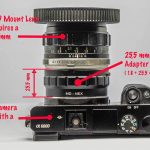
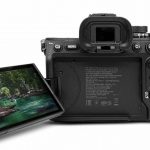
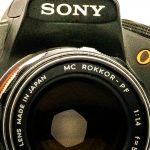



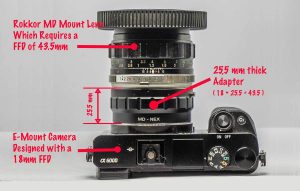

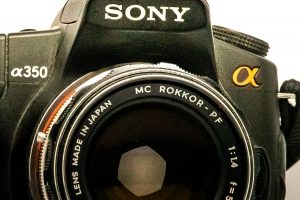

Thank you for a most comprehensive and interesting article. I have a Minolta SRT 101 film camera with a number of Minolta lenses MD 100mm 2.8, 58mm Minolta MC 1.4 which I would like to use on my Sony Alpha 700 and Minolta 7D.
Could you advise me please on the adaptors I require to purchase which are simple to apply to the lens es and camera for use. Many thanks Gordon Joslin.
Hi Gordon,
I am working on an post about MD to A-Mount adapters. Much of what I wrote about the M42 adapters, applies to the MD adapters as well.
You can find many MD to A-Mount adapters on ebay and large photo outlets like B&H Photo. I don’t prefer one brand over another, but make sure you get one that will focus to infinity. There are several A-mount to MD adapters that do not focus to infinity, but are acceptable for close-up work. Get one advertised capable of focusing to infinity.
I would definitely suggest paying the extra cash for a “chipped” adapter that is matched to some of your lenses. That will get you Aperture Priority exposure on the A200 and A300 series as well as Anti-Shake on all Sony Alphas.
Good luck and watch for a MD adapter post in the next few weeks.
— Tom
Hi,
Thanks for the article, you might be interested to know that I have been using a lens baby and a couple of antique M42 lenses on my Konica Minolta 5D for a couple of months now.
I had to ‘turn off’ the mirror lock that is used to prevent you tripping the shutter when a lens is not fitted, this can be found in the tools menu.
I purchased a Minolta AF bayonet to M42 adapter from SRB Griturn and the lenses work very well to infinity – I am used to doing things ‘manually’ and really prefer the experience to auto everything – I guess it depends what type of photography you do or indeed what type of photographer you are –
My Zeiss Pancolar 50mm F2 is a beauty and in my opinion is a superb quality portrait/short telephoto lens on the 5D – stunning bokeh! – I paid £20.00 for it off EBAY – a wee bit cheaper than a modern equivalent.
Thoroughly recommended for contemplative creative photography.
T-mount is not a camera mount like M42 is. T-mount is an interchangeable mount. You screw the T-mount adapter onto the lens and then mount this assembly to a camera. T-mount adapters for a wide range of cameras are (were) available and lots of great lenses. Some even produced to this day.
The normal T-mount has no aperture coupling to the camera body.
T-mount is always manual focus.
I bought a plain M42 adaptor to use wuth my A700. The adaptor is a good fit and I attached a Pentax 50mm lens to it. I set the A700 to manual. I was able to manually focus OK but when I tried to press the shutter I got a message on the LCD – “no lens attached. Shutter locked”. What am I doing wrong ?
Tom
“On the A100 and A700 there is an option in the menu to disable this shutter lock; on both cameras this option is on the second page of the custom menu (gear icon, purple colour on the A100). On the A100 the option is the second of two “Shutter lock†options and should be set to “Off: no lensâ€. On the A700 the option is “Release w/oLens†and should be set to “Enableâ€.” (http://www.flickr.com/groups/sony_alpha/discuss/72157608288010526/)
good luck…
Tom,
Excellent information and exactly what I was looking for. Do you plan to write a Sony A850/900 book I hope? I was a combat photographer in Vietnam from 1968 to 1970. I have a special fondness for Pentax Spotmatic cameras and lenses along with Leicas, the only two trouble free cameras I used there (I never tried a Minolta though). I used to be able to load a Pentax while crawling on my back in a firefight in the dark and they always survived monsoon season too. I have a fairly complete set of Takumar lenses (up to 300mm), can forgo auto-focus and am experienced at estimating exposure but IS would be real attractive. Later I worked as an engineer for Sony so either an A850 or A900 seems a good choice since it is the affordable full frame camera. Is there a reason that an M42 to A850/900 mount adapter could not have a chip with user set control to select focal length so IS would work with multiple focal length lens? Finally, if you purchased an M42 mount adapter where cost was not a big concern which brand or model would you purchase today? Thanks much,
Ed
> There is no way for the Sony Alpha to “read†the focal length of a M42 lens.
Exactly for this reason, modern Pentax DSLRs ask for approximate focal length when a manual lens is mounted. My K20D allows to enter focal length only approximately (to choose one of the presets), but it seems to be enough for the in-body image stabilization.
So probably this can be fixed with firmware if Sony allows for it.
We are now in the enviornment of selling as opposed to selling; too many business homeowners confuse the 2 or suppose they are one and the same. To successfully market your self, you must display to your potential ‘patrons’ you might have what they want. This means making a brand image for yourself that differentiates you enough so people will need to be with you.
Great clear info,been snaping since 72,thanks.
Thanks foor taking the time to share this, real information very well communicated. Thanks again.
Excellent article. I’ve got an M42 adapter for my Alpha and it works well with many M42 lenses; however, (and you’ll have to forgive my ignorance) some of the old Mamiya lenses with the little button on the back of the lens that when depressed will stop down the aperture (I’m not sure what it’s technically named) do not work as I cannot adjust the aperture. Am I making any sense? If so, is there a workaround? Thanks